The Solar System is home to countless remarkable celestial bodies, some of which have unique properties. One such celestial body is Neptune’s moon, Triton, which is a fascinating body with many unique characteristics.
In this article, we will explore the features of Triton, its composition, orbital motion, characteristics, discovery and exploration, and potential opportunities for research and exploration.
Introduction
Triton is the largest of Neptune’s 14 known moons and the only large moon in the Solar System with a retrograde orbit – it moves in the opposite direction to the planet’s rotation.
It is the seventh largest moon in the Solar System, with a diameter of 2700 kilometers, and is the only natural satellite of Neptune that has been detected and studied in detail.
Triton is of great scientific interest due to its unique characteristics. It is the only large moon in the Solar System that does not rotate synchronously with its planet, resulting in one side of the moon being in constant daylight and the other side in constant night.
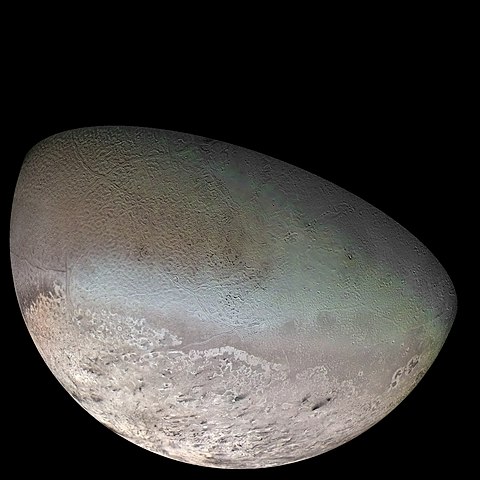
Triton also has a thin nitrogen-dominated atmosphere, which is believed to be the result of geysers spewing out nitrogen from beneath its surface.
Triton’s composition is also of great interest to scientists. It is believed to have a rocky core surrounded by an icy mantle, possibly containing frozen nitrogen or carbon dioxide. The surface of Triton is heavily cratered, indicating that it is a very old body, and is believed to be composed mostly of nitrogen ice, water ice, and carbon dioxide ice.
Due to its retrograde orbit, Triton has a strong gravitational pull on Neptune. This pull causes Neptune’s rotation to slow and the planet’s obliquity – or the angle between its equator and orbital plane – to increase. It is believed that Triton’s gravity is causing Neptune’s orbit to become more eccentric, and the planet’s rotation to become more gradual over time.
The unique characteristics of Triton make it an intriguing body to study. Its composition, atmosphere, and orbital motion offer many opportunities for exploration and research. In the following sections, we will take a closer look at these exciting features of Triton.
Composition
Triton is the largest of Neptune’s known moons and, as such, it provides a unique insight into the composition of the planet’s outer space. Many of its features are still shrouded in mystery, and its composition has only been partially explored.
One of the most fascinating features of Triton is its atmosphere. While its atmosphere is much thinner than that of Earth, its nitrogen-based composition is surprisingly similar.
The atmosphere is composed of roughly 98 percent nitrogen, 1.5 percent methane, and trace amounts of other gases including argon and carbon monoxide. It is also much colder than Earth’s atmosphere, with its temperatures ranging from -226 degrees Celsius to -235 degrees Celsius.
The surface of Triton is particularly interesting. It is comprised of icy materials such as water, ammonia, and methane. The ice is thought to be up to 5 kilometers thick, and the composition of the ice changes depending on where you are on the moon.
Areas near the poles tend to be more heavily comprised of methane ice, while the equatorial region is mostly composed of water ice. On the surface, there are also several large mountains, some of which are up to 5 kilometers high.
The composition of Triton is a source of constant curiosity for scientists. Its atmosphere and surface are thought to be relatively stable, yet the environment on the moon is far from hospitable. As such, its composition remains of great interest to researchers.
Orbital Motion
Triton is the largest moon orbiting the planet Neptune, and there are several features of its orbital motion that make it an intriguing subject for study. To begin with, the orbit of Triton is quite unusual. Unlike most natural satellites, it orbits Neptune in a retrograde direction, meaning it moves opposite of the planet’s rotation.
This orbit is also highly inclined so that it reaches an angle of over 148 degrees.
The rotational motion of Triton also differs from most natural satellites. Triton has an axial tilt of 157.3 degrees which means that it is almost upside down. This is thought to be caused by an event in the past where it was impacted by an object and its orbit shifted.
Triton’s gravitational effects on Neptune are some of the most interesting aspects of its orbit. It causes Neptune’s obliquity, which is the angle between the planet’s equator and its orbital plane. Triton has a large mass and its orbital resonance with Neptune helps to stabilize the planet’s tilt.
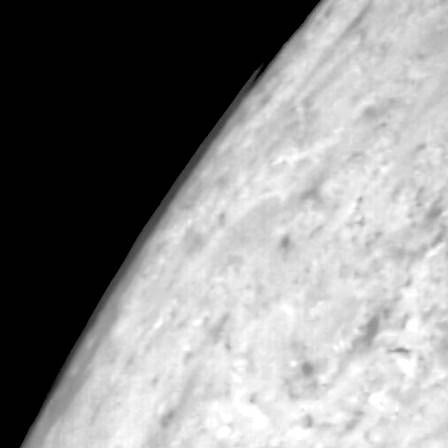
Triton is also the only moon of Neptune that is known to be in a 1:1 orbital resonance, meaning that its orbital period is equal to the planet’s rotational period. This means that it always stays in the same position in Neptune’s sky and is well-shielded from the sun’s radiation.
Finally, Triton’s gravitational pull is so strong that it influences the shape of Neptune’s orbit, making it slightly oval-shaped. This causes Neptune’s distance from the sun to vary slightly depending on its position in its orbit. This is an interesting phenomenon as most planets have nearly circular orbits.
Taken together, these features of Triton’s orbital motion provide researchers with a unique opportunity to study the gravitational interactions between planets and their moons. This can provide insight into how planets and their moons interact in different solar systems, and can even help us understand our own solar system better.
Characteristics
Triton is the largest and most fascinating of Neptune’s moons, and its unique characteristics make it an intriguing subject for study.
This moon has an unusual atmosphere and surface features that make it distinct from the other moons of the Solar System. Let’s explore some of Triton’s most fascinating characteristics.
Temperature of Triton
Triton’s temperature is quite peculiar. At its equator, the temperature hovers around -235 degrees Celsius while the poles sit at -220 degrees Celsius.
This extreme temperature for a solar system body is thought to be caused by the moon’s high albedo.
Albedo is the measure of a planet’s or moon’s ability to reflect sunlight, and Triton has one of the highest albedos of any moon in the Solar System.
Age of Triton
Triton is believed to be one of the oldest moons in the Solar System, estimated to be about 4 billion years old. Its age is thought to be much older than the planets, and it is thought to be one of the first objects to form in the Solar System.
This explains the moon’s lack of craters, as the Solar System was full of debris and asteroids when it was formed.
Unique Characteristics of Triton
Triton is the only known moon in the Solar System with a retrograde orbit, meaning it moves around Neptune in the opposite direction of the planet’s rotation. This is believed to be the result of a collision between Neptune and another large object in its past.
The moon also has an exceptionally tenuous nitrogen-rich atmosphere, making it unique in the Solar System as the only known moon with an atmosphere.
The nitrogen is believed to be sourced from Triton’s surface ice, which is heated up and then released into the atmosphere by the heat of the Sun.
Finally, Triton has a unique surface feature called “cantaloupe terrain”. This terrain is composed of ridges and mountains that run in an east-west direction and is believed to have been formed by the gravitational pull of Neptune on the moon’s surface.
These unique characteristics of Triton make it an interesting and exciting object of study. Its retrograde orbit, tenuous atmosphere, and cantaloupe terrain are just some of the things that make this moon so intriguing.
Further study of Triton could reveal more about its fascinating characteristics, as well as offer clues about the formation of our Solar System.
Discovery and Exploration
Triton is one of the most interesting moons of Neptune, and its discovery and exploration have revealed a great deal of information about the outer reaches of our solar system. Triton was discovered in 1846 by British astronomer William Lassell, who observed it through his telescope while scanning the sky for Neptune’s other moons.
Lassell had initially assumed that Triton was a star, but further observations revealed that it was in fact a moon of Neptune.
Since Triton was first discovered, it has been extensively studied both from Earth and from spacecraft, and its unique characteristics have been the subject of much research. From the Voyager 2 mission in 1989, scientists were able to observe Triton’s composition and its unique characteristics.
Its atmosphere was found to be composed of nitrogen and carbon dioxide, and its surface features include geysers, frozen nitrogen, and a variety of other geological features.
The orbit of Triton around Neptune is slightly unusual. It is in a retrograde orbit, meaning it orbits in the opposite direction of the planet’s rotation. This phenomenon is thought to be due to a gravity assist from one of Neptune’s other moons, which resulted in Triton being captured by Neptune’s gravitational field.
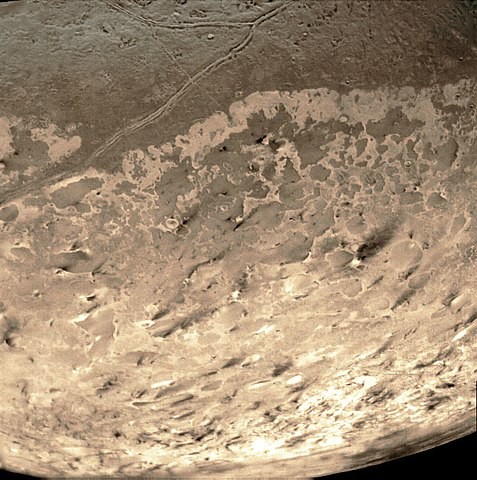
In addition, the gravitational pull of Triton has an effect on the orbit of Neptune’s other moons, and it is believed that Triton has even caused some of Neptune’s moons to disappear over time.
The temperature of Triton is surprisingly cold. It is estimated to be -235 degrees Celsius, which is much colder than what is found at the Earth’s poles. This is likely due to its distance from the sun and the fact that it is not heated by solar energy. The age of the moon is also believed to be much younger than many of the other moons in the solar system.
The exploration of Triton has enabled us to gain a greater understanding of the outer reaches of our solar system. It has provided us with insight into the unique characteristics of this distant moon, and also the potential opportunities for exploration and research.
The information that we have gathered from studying Triton has allowed us to gain a better understanding of the environment of Neptune and its moons and has given us an opportunity to gain insight into how and why Triton behaves the way it does.
Future Research and Opportunities
Triton, the fascinating moon of Neptune, is a unique and mysterious celestial body. With its unique atmosphere, surface features, and orbital motion, it gives astronomers, scientists, and engineers an exciting opportunity to explore the depths of our solar system. In addition to the current research that has been conducted on Triton, there are still a few areas that can be further studied in order to gain a better understanding of its characteristics and opportunities for exploration.
One area of research that scientists are interested in studying further is the composition of Triton’s atmosphere. Triton’s atmosphere is made up of nitrogen and methane, and is very thin compared to other moons.
Scientists believe that this rarity could potentially provide clues into the origin of the moon. Additionally, the atmosphere of Triton could provide clues about its past climate, as well as its evolution over time.
The surface features of Triton are also of great interest to researchers. The unique features of Triton’s surface include its unusual color, which is caused by the reflection of sunlight off its icy surface. Additionally, Triton’s surface has a wide variety of features, from canyons to craters, that can help researchers to understand the moon’s geological history.
Further study of Triton’s surface could also provide insight into the age of the moon, as well as the potential for eruptive activity.
The orbit of Triton is another area of research that could be studied further. Triton’s orbit is retrograde, meaning that it orbits Neptune in the opposite direction from the rest of the moons.
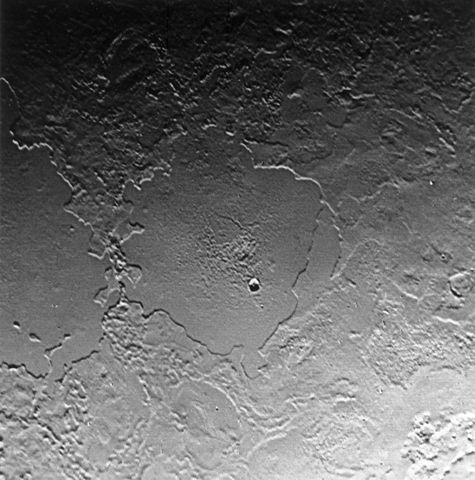
This unique motion also affects the gravitational interactions between Triton and Neptune, and further research could provide insight into the origin of the moon’s retrograde orbit.
The temperature of Triton is also a fascinating aspect of the moon that scientists are interested in researching further. The temperature of Triton can range from -345°F to -400°F, and scientists are interested in studying the dynamic nature of the moon’s temperature to gain a better understanding of its characteristics.
The discovery and exploration of Triton is an area of research that has been conducted since its initial discovery in 1846. While scientists have gained some knowledge about the moon’s history and characteristics, there are still many opportunities for further exploration.
For example, future missions could be conducted to explore the moon’s surface in greater detail. Additionally, studying Triton’s composition could lead to new discoveries about its internal structure and composition.
Finally, studying Triton could lead to potential applications in areas such as space exploration and the development of new technologies. The moon’s unique properties could be used to develop new propulsion systems and provide insight into the origin of our solar system.
Additionally, Triton’s low temperatures could be utilized for cryogenic storage, which could be beneficial for astronauts and other scientists in space.
Overall, Triton is a unique and mysterious moon that has presented scientists with a variety of research and exploration opportunities. From its composition to its orbit, Triton is a fascinating celestial body that offers a variety of potential applications for future research and exploration.
Facts
Triton is the largest of Neptune’s moons.
It is the seventh-largest moon in the Solar System,
It was discovered by the English astronomer William Lassell in October 1846
Triton was the son of the sea god Poseidon in Greek mythology
Triton has a retrograde orbit
Triton is unique because it is the largest moon to orbit its parent body in the wrong direction
Triton is thought to have been a dwarf planet, captured from the Kuiper belt
Triton’s rotation is tidally locked to be synchronous with its orbit around Neptun
The moon’s distance from its parent planet is about 220,405 miles
Triton has a tenuous nitrogen atmosphere, with trace amounts of carbon monoxide and small amounts of methane near its surface
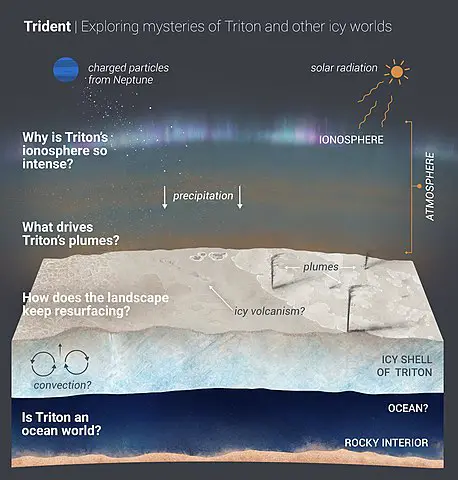
40% of Triton’s surface was imaged by Voyager 2
Fifty-five percent of Triton’s surface is covered with frozen nitrogen
water ice comprises 15–35% and frozen CO2 forming the remaining 10–20% of Triton’s surface
Triton is one of the few bodies in the Solar System on which active eruptions of some sort have been observed
The geysers of Triton spew out nitrogen from beneath the surface into plumes that can rise as high as 8 kilometres.
Triton’s largest known impact crater is about 27 kilometers in diameter.
Triton is very young with regions varying from an estimated 50 million years old to 6 million years old.
Triton’s known surface is crisscrossed by rift valleys and ridges, which suggest volcanic and tectonic activity
The volcanoes on Triton spew water ice and ammonia
It is believed that Triton will get too close to Neptune in about 3.5 billion years and the gravitational pull will break up Triton.
The result of this may be a ring system
Voyager 2 was the only spacecraft to visit and map Triton. It flew by in 1989
Triton’s orbit around Neptune is almost perfectly circular
Information
| Discovery | |
|---|---|
| Discovered by | William Lassell |
| Discovery date | October 10, 1846 |
| Designations | |
|
Designation
|
Neptune I |
| Pronunciation | traɪtən |
|
Named after
|
Trītōn |
| Orbital characteristics | |
|
Semi-major axis
|
354,759 km |
| Eccentricity | 0.000016 |
|
Orbital period (sidereal)
|
5.876854 d (retrograde) |
|
Average orbital speed
|
4.39 km/s |
| Inclination | 129.812° (to the ecliptic) 156.885° (to Neptune’s equator) 129.608° (to Neptune’s orbit) |
| Satellite of | Neptune |
| Physical characteristics | |
|
Mean radius
|
1,353.4±0.9 km (0.2122 REarth) |
|
Surface area
|
23,018,000 km2 |
| Volume | 10,384,000,000 km3 |
| Mass | (2.1390±0.0028)×1022 kg (0.00359 Earths) |
|
Mean density
|
2.061 g/cm3 |
|
Surface gravity
|
0.779 m/s2 (0.0794 g) (0.48 Moons) |
|
Escape velocity
|
1.455 km/s |
|
Synodic rotation period
|
synchronous |
|
Sidereal rotation period
|
5 d, 21 h, 2 min, 53 s |
|
Axial tilt
|
0 |
| Albedo | 0.76 |
| Temperature | 38 K (−235.2 °C) |
|
Apparent magnitude
|
13.47 |
|
Absolute magnitude (H)
|
−1.2 |
| Atmosphere | |
|
Surface pressure
|
1.4 to 1.9 Pa (1.38×10−5 to 1.88×10−5 atm) |
|
Composition by volume
|
nitrogen; methane traces |
